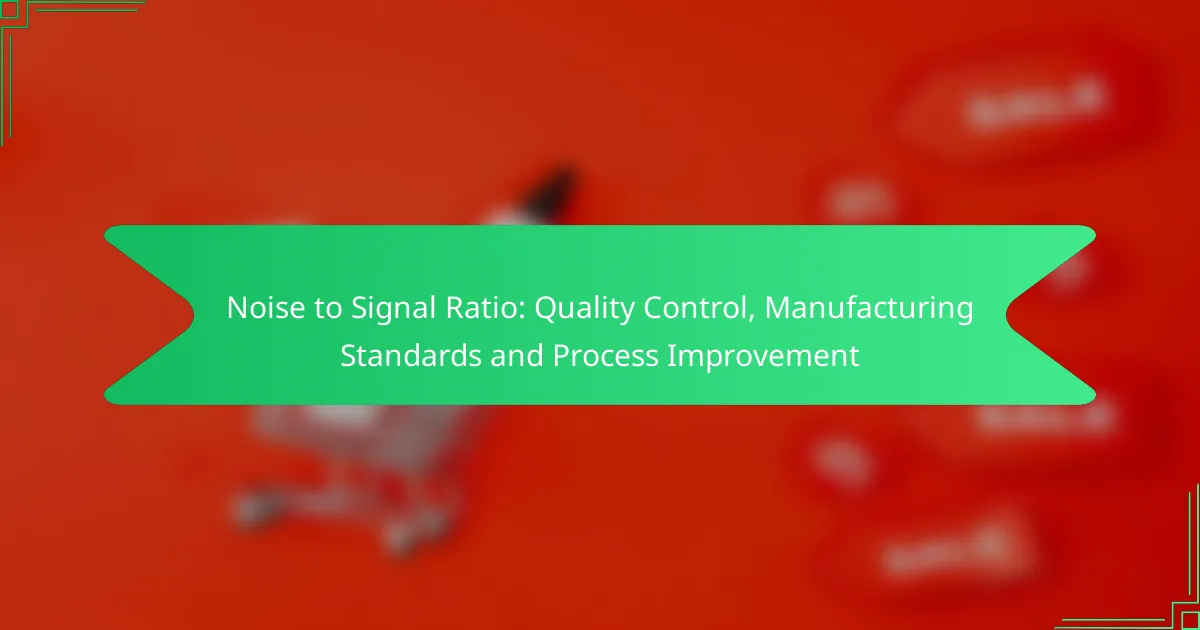The noise to signal ratio (NSR) is a critical factor in manufacturing that influences quality control and process improvement. By enhancing the NSR, manufacturers can achieve clearer data signals, leading to more effective identification of defects and inconsistencies. Implementing systematic approaches such as Six Sigma methodologies and advanced measurement tools is essential for optimizing product quality and reducing variability.

What are the best practices for improving noise to signal ratio in manufacturing?
Improving the noise to signal ratio in manufacturing involves implementing systematic approaches that enhance product quality and reduce variability. Key practices include adopting Six Sigma methodologies, utilizing statistical process control, conducting regular quality audits, investing in advanced measurement tools, and training staff on quality standards.
Implementing Six Sigma methodologies
Six Sigma is a data-driven approach that aims to minimize defects and variability in manufacturing processes. By applying the DMAIC (Define, Measure, Analyze, Improve, Control) framework, organizations can systematically identify sources of noise and implement targeted improvements.
For example, a manufacturing plant might define a specific defect rate as a target, measure current performance, analyze root causes of noise, implement process changes, and then control the new processes to maintain improvements. This structured approach can lead to significant enhancements in the noise to signal ratio.
Utilizing Statistical Process Control (SPC)
Statistical Process Control (SPC) involves using statistical methods to monitor and control manufacturing processes. By analyzing data in real-time, manufacturers can detect variations that may indicate increased noise levels.
Common SPC tools include control charts and process capability analysis. These tools help identify trends and outliers, allowing for timely interventions to maintain optimal performance and improve the signal quality in production processes.
Conducting regular quality audits
Regular quality audits are essential for identifying areas where noise may be affecting product quality. These audits should assess compliance with established standards and identify potential sources of variability.
During an audit, manufacturers can evaluate process documentation, conduct equipment inspections, and review employee adherence to quality protocols. This proactive approach helps to ensure that processes remain within acceptable noise levels and supports continuous improvement efforts.
Investing in advanced measurement tools
Advanced measurement tools, such as laser measurement systems and automated inspection equipment, can significantly enhance the ability to detect noise in manufacturing. These tools provide precise data that can help identify deviations from desired specifications.
Investing in such technology can lead to improved accuracy and reliability in measurements, ultimately enhancing the signal quality. Organizations should evaluate the cost versus benefits of these tools to ensure they align with their quality improvement goals.
Training staff on quality standards
Training staff on quality standards is crucial for maintaining a low noise to signal ratio. Employees should be well-versed in the quality expectations and the importance of their roles in achieving these standards.
Regular training sessions and workshops can reinforce best practices and encourage a culture of quality within the organization. This investment in human capital not only improves individual performance but also contributes to overall process stability and quality assurance.

How does noise to signal ratio impact quality control?
The noise to signal ratio (NSR) significantly affects quality control by determining the clarity of data collected during manufacturing processes. A lower NSR indicates clearer signals, which leads to better identification of defects and inconsistencies in products.
Reduces defect rates
A low noise to signal ratio helps in accurately detecting defects during production. When the signal is stronger than the noise, quality control systems can identify issues early, reducing the likelihood of defective products reaching customers. Implementing regular monitoring and calibration can help maintain an optimal NSR.
For example, using advanced sensors and data analytics can enhance the detection capabilities, potentially lowering defect rates by significant margins, often in the range of single-digit percentages.
Enhances product consistency
Improving the noise to signal ratio contributes to greater product consistency by ensuring that manufacturing processes are closely monitored and controlled. When the signals are clear, variations in production can be minimized, leading to uniformity in product quality. This consistency is crucial for maintaining brand reputation and customer trust.
Manufacturers can achieve this by standardizing processes and utilizing automated systems that rely on real-time data, which helps maintain a strong signal amidst potential noise.
Improves customer satisfaction
A better noise to signal ratio directly correlates with higher customer satisfaction. When products are consistently high-quality and defects are minimized, customers are more likely to have positive experiences. This satisfaction can lead to repeat business and positive word-of-mouth referrals.
To enhance customer satisfaction, companies should focus on continuous improvement practices that monitor and optimize the NSR, ensuring that quality control measures are effective and responsive to any changes in production conditions.

What are the key metrics for measuring noise to signal ratio?
The key metrics for measuring noise to signal ratio include signal strength, noise level, and process capability index (Cpk). These metrics help assess the quality of a manufacturing process and identify areas for improvement.
Signal strength
Signal strength refers to the amplitude or intensity of the desired signal in a manufacturing process. A higher signal strength indicates a clearer and more reliable output, which is crucial for maintaining quality standards. It is often measured in decibels (dB) or as a percentage of the maximum possible signal.
To improve signal strength, ensure that the equipment used is properly calibrated and maintained. Regular checks can help identify any deviations that may weaken the signal, allowing for timely adjustments.
Noise level
Noise level represents the unwanted variations or disturbances that can interfere with the signal. This can include random fluctuations in measurements or external factors affecting production. Keeping noise levels low is essential for achieving a high noise to signal ratio.
Common sources of noise include machinery vibrations, environmental conditions, and human error. Implementing standardized operating procedures and regular training can help mitigate these noise sources, enhancing overall process reliability.
Process capability index (Cpk)
The process capability index (Cpk) measures how well a process can produce output within specified limits. A higher Cpk value indicates a more capable process with less variation, which is vital for maintaining quality control. Typically, a Cpk of 1.33 or higher is considered acceptable in many industries.
To calculate Cpk, assess the mean and standard deviation of the process data in relation to the specification limits. Regular monitoring and adjustments based on Cpk results can lead to significant improvements in the noise to signal ratio, ultimately enhancing product quality.

What manufacturing standards address noise to signal ratio?
Manufacturing standards that address noise to signal ratio focus on ensuring quality control and process improvement by minimizing variability and enhancing signal clarity in production processes. These standards provide frameworks for organizations to systematically manage quality and reduce noise, leading to more reliable outcomes.
ISO 9001 Quality Management Systems
ISO 9001 is a widely recognized standard that sets out the criteria for a quality management system. It emphasizes a process approach, which helps organizations identify and mitigate noise in their operations, thus improving the signal quality of their outputs. By implementing ISO 9001, companies can establish clear quality objectives and continuously monitor performance.
To effectively address noise to signal ratio under ISO 9001, organizations should focus on regular audits, employee training, and customer feedback mechanisms. These practices ensure that processes remain aligned with quality objectives and that any deviations are promptly addressed.
AS9100 Aerospace Quality Management
AS9100 builds on ISO 9001 with additional requirements specific to the aerospace industry, emphasizing safety and reliability. This standard includes rigorous controls to minimize noise in manufacturing processes, which is critical in aerospace applications where precision is paramount. Adopting AS9100 helps organizations improve their signal quality by enforcing strict documentation and traceability.
Organizations should implement risk management practices to identify potential sources of noise and develop mitigation strategies. Regular training and adherence to best practices in quality assurance can significantly enhance the overall signal quality in aerospace manufacturing.
ISO/TS 16949 Automotive Quality Management
ISO/TS 16949 is tailored for the automotive sector and integrates quality management principles with a focus on continuous improvement. This standard helps automotive manufacturers reduce noise by standardizing processes and fostering collaboration among suppliers. By addressing noise to signal ratio, companies can enhance product reliability and customer satisfaction.
To effectively manage noise, automotive manufacturers should establish clear metrics for quality performance and engage in regular supplier evaluations. Continuous monitoring and feedback loops can help identify noise sources early, allowing for timely corrective actions that improve overall signal integrity.

What are the challenges in achieving optimal noise to signal ratio?
Achieving an optimal noise to signal ratio (NSR) is challenging due to various factors that can compromise measurement accuracy and data integrity. Key challenges include inconsistent measurement techniques, environmental influences, and equipment limitations that can introduce noise, making it difficult to isolate the actual signal.
Inconsistent measurement techniques
Inconsistent measurement techniques can significantly affect the noise to signal ratio. Variability in how measurements are taken, including differences in equipment calibration, operator methods, and data recording practices, can lead to unreliable results. For instance, using different types of sensors or measurement protocols can yield varying levels of noise, complicating data analysis.
To mitigate these inconsistencies, standardizing measurement procedures is essential. Implementing a uniform calibration schedule and training personnel on best practices can help ensure that measurements are taken consistently. Regular audits of measurement techniques can also identify discrepancies and areas for improvement.
Environmental influences
Environmental factors such as temperature, humidity, and electromagnetic interference can introduce additional noise, impacting the overall signal quality. For example, fluctuations in temperature can affect sensor performance, leading to increased noise levels. Additionally, nearby machinery or electronic devices can emit electromagnetic interference that distorts signals.
To counteract these environmental influences, it is crucial to control the measurement environment as much as possible. This may involve using shielding for sensitive equipment, maintaining stable temperature conditions, and conducting measurements in isolated areas to minimize external noise sources.
Equipment limitations
Equipment limitations play a significant role in determining the noise to signal ratio. Older or lower-quality instruments may have inherent noise levels that are higher than those of more advanced models. Additionally, the choice of sensors and data acquisition systems can greatly impact the ability to capture clean signals.
Investing in high-quality, modern equipment can improve the NSR significantly. Regular maintenance and updates to measurement tools are also critical to ensure optimal performance. Furthermore, selecting the appropriate equipment for specific applications can help reduce noise and enhance signal clarity.










